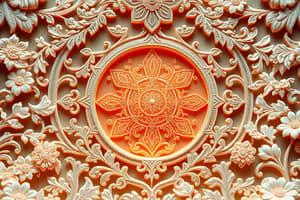Podcast
Questions and Answers
What is the primary function of the z1-axis in a Delta 3D Printer?
What is the primary function of the z1-axis in a Delta 3D Printer?
- To control the movement of the print nozzle along the z-axis (correct)
- To control the movement of the print bed along the y-axis
- To control the rotation of the print nozzle
- To control the movement of the print nozzle along the x-axis
Which material is NOT commonly used in 3D printing?
Which material is NOT commonly used in 3D printing?
- PLA
- ABS
- Wood (correct)
- Nylon
What happens if a user follows an incorrect sequence during the assembly of a Delta 3D Printer?
What happens if a user follows an incorrect sequence during the assembly of a Delta 3D Printer?
- The parts will automatically rearrange themselves
- A pop-up will appear on the screen showing the name of the part to be selected (correct)
- The parts will continue to assemble regardless of the sequence
- The simulation will reset
What type of license does the Virtual Labs Mechanical Engineering simulation use?
What type of license does the Virtual Labs Mechanical Engineering simulation use?
What should a user do to observe the movement of the z2-axis assembly?
What should a user do to observe the movement of the z2-axis assembly?
What is the purpose of the 'Assembly of Delta 3D Printer' simulation?
What is the purpose of the 'Assembly of Delta 3D Printer' simulation?
What happens if a user enters a value outside the given range in the z-axis text box?
What happens if a user enters a value outside the given range in the z-axis text box?
Which of the following is a type of 3D printer?
Which of the following is a type of 3D printer?
What is the role of the print nozzle in a 3D printer?
What is the role of the print nozzle in a 3D printer?
What should a user do to assemble the parts of the Delta 3D Printer in the correct sequence?
What should a user do to assemble the parts of the Delta 3D Printer in the correct sequence?
Flashcards are hidden until you start studying
Study Notes
Types of 3D Printers
- Cartesian 3D printers are based on a system of three mutually perpendicular axes (X, Y, and Z axes) and exhibit linear motion along these axes.
- Polar 3D printers work on polar (R-θ) coordinates, with the extruder assembly moving along the vertical axis and the print bed rotating and reciprocating horizontally.
- Delta 3D printers have the extruder assembly suspended along three connecting rods, forming a triangular shape.
Anatomy of a 3D Printer
- The anatomy of a 3D printer consists of both mechanical and electrical structures.
3D Printer Components
- A Cartesian printer typically uses 3 motors.
- The extruder moves in both X and Z directions.
- A 3D printer typically uses 3 end stops.
Filaments Used in 3D Printing
- PLA, ABS, and Nylon are common filaments used in 3D printing.
Simulation Objectives
- Students will be able to simulate the operation of a 3D printer for different parameters and analyze the effect of these parameters on the printer's performance.
- Students will be able to build a 3D printer using different parts and learn about assembly without damaging the parts.
- Students will be able to answer questions related to part functioning and assembly of the 3D printer.
Delta 3D Printer Simulation
- The simulation aims to construct a delta 3D printer and provide in-depth knowledge of its mechatronics.
Assembly of Delta 3D Printer
- The assembly process involves selecting parts in a sequence and assembling them correctly.
- Incorrect sequence selection will result in a pop-up error message.
Playing with Axes
- The simulation allows users to move the z1-axis and z2-axis sliders or enter values within a given range to observe the movement of the respective axis assemblies.
Studying That Suits You
Use AI to generate personalized quizzes and flashcards to suit your learning preferences.




